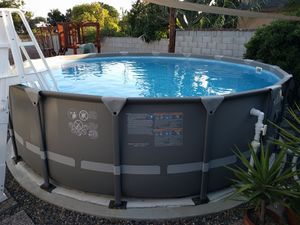| Line 11: | Line 11: | ||
===Spray with Rust-Oleum=== | ===Spray with Rust-Oleum=== | ||
Spraying everything with 2 coats of Rust-Oleum.<ref>https://www.troublefreepool.com/threads/grease-your-intex-connections.193155/post-1702877</ref> | Spraying everything with 2 coats of Rust-Oleum.<ref>https://www.troublefreepool.com/threads/grease-your-intex-connections.193155/post-1702877</ref> | ||
| + | |||
| + | The best way to prevent it is to coat the inside and edges of the uprights and fittings before installing them. | ||
| + | Dip them in some good enamel paint and hang them to dry and them assemble it and touch up any scratched areas.<ref>https://www.troublefreepool.com/threads/intex-pools-how-to-prevent-rust.177433/post-1567263</ref> | ||
===Sealing the Legs=== | ===Sealing the Legs=== | ||
Revision as of 02:08, 2 September 2019
Intex makes popular Above Ground Pools.
How to Prevent Intex Pool from Rusting
Rust is a common problem with Intex and other above ground pools. AGPs are typically outdoors, and are exposed to the elements, and moisture. As such, rust will form. Its inevitable, however, we can slow down the process a bit and take precautions.
Some of the things that members have tried are described below.
Grease your Intex connections
Grease everywhere that the poles connected to avoid rust. There is apparently a YouTube video that shows this technique.[1]
Spray with Rust-Oleum
Spraying everything with 2 coats of Rust-Oleum.[2]
The best way to prevent it is to coat the inside and edges of the uprights and fittings before installing them. Dip them in some good enamel paint and hang them to dry and them assemble it and touch up any scratched areas.[3]
Sealing the Legs
- Use silicone to seal the bottom of the legs where they join the cups.
- Use 2" self-fusing silicone tape to wrap the top of the legs where they connect to the joints (being sure to completely cover the holes/pins).
Flaps to Prevent Water Splashing Into the T-Connectors
Cut a flap of vinyl and glue it to the inside of the pool (being sure to also glue it down to the vinyl hanging over the top rail) and then hang it over the edge? The flap hanging over could easily be secured to the leg with a zip tie, or even a magnet.
Flaps were patterned and then cut out of vinyl coated PVC fabric and glued with HH-66 vinyl cement. The black "buttons" are strong neodimium magnets. They came epoxy coated but I'll probably use the leftover Rust-Oleum I used on the support poles to paint them gray as well.[4]
The bottom of the flaps are square and rolled underneath. This forms two funnels on the sides of each flap that blocks water from reaching the t-connectors and allows any water coming in on the sides to flow out the bottom. The magnet holds the folded-in corners to the upright.
The inside of the pool is now completely sealed, no water can splash through the openings and get into the t-connectors now. Of course, this mod depends on the through-the-wall skimmer I had added previously to ensure the water level has an overflow point to prevent accidental overfilling.
- ↑ https://www.troublefreepool.com/threads/grease-your-intex-connections.193155/post-1702410
- ↑ https://www.troublefreepool.com/threads/grease-your-intex-connections.193155/post-1702877
- ↑ https://www.troublefreepool.com/threads/intex-pools-how-to-prevent-rust.177433/post-1567263
- ↑ https://www.troublefreepool.com/threads/idea-to-help-keep-water-out-of-intex-rails-and-t-connectors.182161/post-1664002


